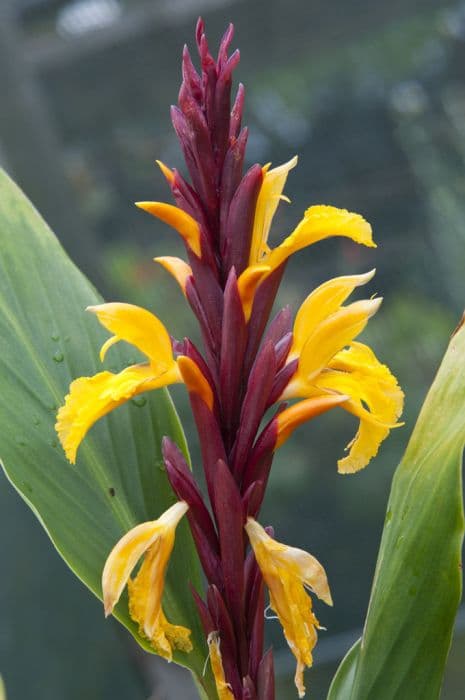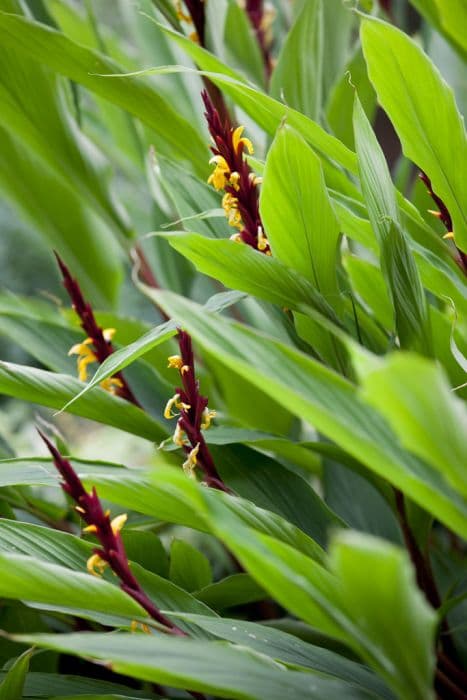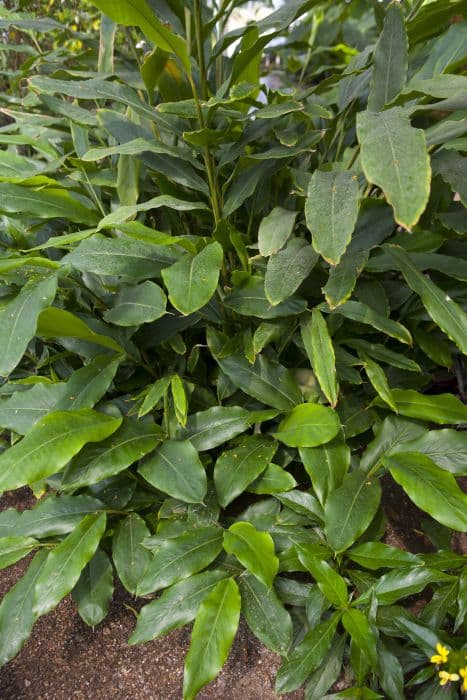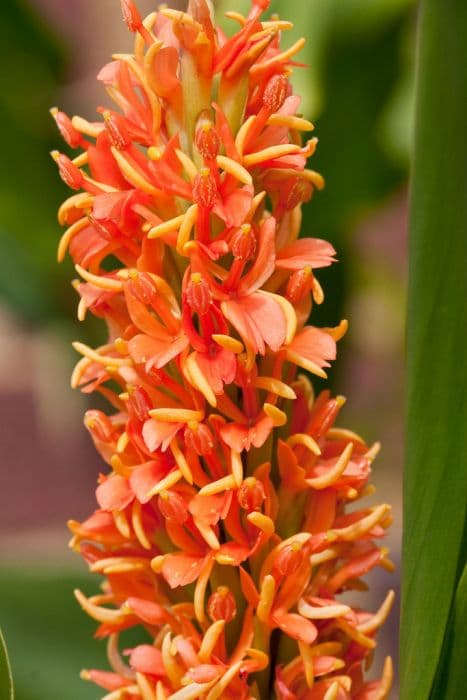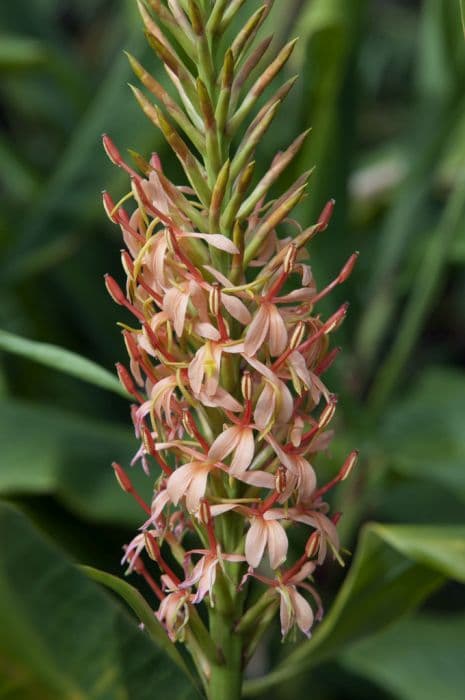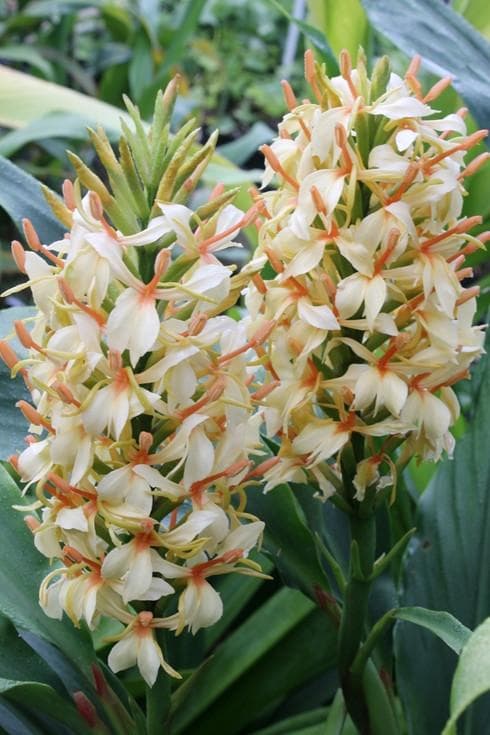Japanese ginger Zingiber mioga

ABOUT
The plant known as Japanese ginger or mioga ginger is a perennial herb with a notable aesthetic. Its underground part consists of fleshy, cream-colored rhizomes, similar to those of culinary ginger but not typically used for flavoring. The leaves of this plant are broad, elongated, and vividly green, forming a lush clump with a tropical appearance. They are typically arranged alternately on the stem, with a smooth margin and a pointed tip. During summer or early fall, it produces unique flower buds that emerge at ground level or just above it. These buds are small and a pale yellow-white color. Rather than being showy, the flowers are valued for their subtle beauty and sometimes used in traditional Japanese cuisine. After flowering, small capsules may form containing numerous seeds. This ginger variety is not only appreciated for its ornamental leaves and flowers but also for its resilience to cold temperatures compared to other gingers. The overall appearance of Japanese ginger is that of a refined and lush plant that offers a sense of an exotic garden without the need for a tropical climate.
About this plant
 Names
NamesFamily
Zingiberaceae.
Synonyms
Myoga Ginger, Japanese Ginger, Myoga, Mioga.
Common names
Amomum mioga, Zingiber mioga var. mioga, Zingiber mioga var. tosaense.
 Toxicity
ToxicityTo humans
The plant known as Japanese ginger is generally recognized as safe for humans to consume. There are no well-documented reports of toxicity or poisoning from the consumption of Japanese ginger. Therefore, ingesting this plant typically does not lead to any adverse health consequences for humans.
To pets
Japanese ginger is not known to be toxic to pets either. It is not listed among commonly recognized poisonous plants for dogs, cats, or other household animals. Ingesting Japanese ginger should not lead to any specific symptoms of poisoning or toxicity in pets, and there should be no harmful consequences from pets consuming parts of this plant. However, it is always prudent to monitor your pet and consult a veterinarian if any unusual behavior or symptoms occur after ingestion.
 Characteristics
CharacteristicsLife cycle
Perennials
Foliage type
Deciduous
Color of leaves
Green
Flower color
Yellow
Height
2-3 feet (0.6-0.9 meters)
Spread
2-3 feet (0.6-0.9 meters)
Plant type
Herb
Hardiness zones
7
Native area
Japan
Benefits
 General Benefits
General Benefits- Culinary Use - The young shoots and flower buds of Zingiber mioga, commonly known as Japanese ginger or myoga, are used in traditional Japanese and Korean cuisine for their unique flavor.
- Ornamental Plant - With its attractive foliage and distinctive flowers, myoga adds aesthetic value to gardens and landscaping designs.
- Easy Cultivation - Myoga ginger is considered easy to grow and can thrive in a variety of soil types, making it suitable for home gardening.
- Shade Tolerance - This plant can grow in partial shade, which makes it a good choice for understory planting in forested garden areas or shaded sections of the yard.
- Perennial Growth - As a perennial plant, myoga regrows every year once established, providing a recurring harvest without the need for annual replanting.
- Low Maintenance - Myoga doesn't require extensive maintenance, making it a convenient plant for gardeners of all skill levels.
 Medical Properties
Medical Properties- Anti-inflammatory: Zingiber mioga is believed to have anti-inflammatory properties, which might be useful in reducing inflammation.
- Antioxidant: The plant may contain compounds that have antioxidant effects, potentially neutralizing damaging free radicals in the body.
- Gastrointestinal relief: Zingiber mioga is sometimes used to alleviate symptoms of digestive discomfort.
- Anti-cancer potential: Preliminary studies suggest there might be compounds in Zingiber mioga that could have anti-cancer effects. However, more research is needed to confirm this.
- Neuroprotective effects: Some research indicates Zingiber mioga might have neuroprotective properties, which could be beneficial for brain health.
 Air-purifying Qualities
Air-purifying QualitiesThis plant is not specifically known for air purifying qualities.
 Other Uses
Other Uses- Culinary Decoration: The flower buds of Japanese ginger can be used as an elegant garnish on salads or sushi platters, adding both color and a unique flavor.
- Insect Repellent: The plant emits a scent that can deter certain insects, making it a natural option for planting in gardens to protect other plants.
- Natural Fabric Dye: The roots of Japanese ginger can be used to produce a natural dye for fabrics, yielding a yellow to orange color.
- Floral Arrangements: The flowers and shoots of Japanese ginger can be included in floral arrangements for their aesthetic appeal and exotic look.
- Leaf Wraps: The large leaves can be used to wrap food for cooking, infusing a subtle flavor and keeping the food moist.
- Companion Planting: When grown alongside other plants, Japanese ginger can provide beneficial shade and help maintain moist soil conditions.
- Cultural Ceremonies: In some cultures, parts of the Japanese ginger plant are used in traditional ceremonies and rituals.
- Erosion Control: The robust root system of Japanese ginger can help stabilize soil and control erosion in garden settings.
- Perfumery: Essential oils derived from Japanese ginger can be used in making perfumes and scented products with its distinctive fragrance.
- Edible Landscaping: Japanese ginger provides an aesthetic appeal for ornamental gardens, while also offering edible parts for culinary use.
Interesting Facts
 Feng Shui
Feng ShuiThe plant Mioga Ginger is not used in Feng Shui practice.
 Zodiac Sign Compitability
Zodiac Sign CompitabilityThe plant Mioga Ginger is not used in astrology practice.
 Plant Symbolism
Plant Symbolism- Energizing: Zingiber mioga, commonly known as Japanese ginger, is often associated with energy due to its pungent and invigorating flavor, similar to that of traditional ginger. It symbolizes the injection of vigor and vitality into life.
- Healing: In traditional medicine, Japanese ginger has been used for its health benefits, thus it symbolizes healing and the soothing of ailments.
- Uniqueness: As it is less well-known than common ginger, Japanese ginger symbolizes uniqueness and a sense of exoticness.
- Culinary Inspiration: Often used in Japanese cuisine, the plant symbolizes culinary creativity and inspiration, inviting culinary artists to explore new flavors and dishes.
- Longevity: Given its use in traditional healing practices and its perennial nature, Japanese ginger may symbolize long life and enduring health.
 Water
WaterThe Japanese ginger or mioga should be watered deeply once a week, ensuring that the soil is kept consistently moist but not soggy. During the growing season, it may require more frequent watering, especially in dry conditions, with approximately one to two gallons per week depending on the size of the plant and environmental factors. In winter, when the plant is dormant, water less frequently, allowing the soil to almost dry out between waterings. Always check the soil moisture before watering to ensure it needs it, as overwatering can lead to root rot.
 Light
LightJapanese ginger thrives in partial shade to filtered sunlight, which mimics its natural habitat under the canopy of taller trees. A spot that receives morning light with afternoon shade or a location with dappled sunlight throughout the day is ideal. Avoid placing it in direct, harsh afternoon sunlight as this can scorch the leaves.
 Temperature
TemperatureJapanese ginger prefers moderate temperatures and does well in conditions that are typically between 60°F and 80°F. This plant can generally tolerate a temporary dip down to 15°F but should be protected from frost, which can damage the foliage. For optimal growth, maintain a consistent temperature range and avoid exposure to extreme heat or cold drafts.
 Pruning
PruningPrune Japanese ginger or mioga primarily to remove dead or damaged foliage and to shape the plant if desired. Pruning is best done in late winter or early spring before new growth begins. Occasionally, trimming may be necessary to remove spent flower stems to encourage further flowering. Pruning is not typically required frequently but should be done as needed to keep the plant healthy and attractive.
 Cleaning
CleaningAs needed
 Soil
SoilThe Japanese ginger or myoga requires well-draining and fertile soil with a pH between 5.5 and 6.5. A good mix would be one part garden soil, one part peat moss, and one part perlite or sand.
 Repotting
RepottingJapanese ginger should be repotted every 2-3 years or when it outgrows its pot, to refresh the soil and give the roots more room to grow.
 Humidity & Misting
Humidity & MistingJapanese ginger thrives in high humidity environments; maintaining a humidity level of 60-80% is ideal for this plant.
 Suitable locations
Suitable locationsIndoor
Bright indirect light, keep soil moist, high humidity.
Outdoor
Plant in partial shade, protect from strong winds, mulch well.
Hardiness zone
7-10 USDA
 Life cycle
Life cycleZingiber mioga, commonly known as Japanese ginger or mioga ginger, begins its life as a rhizome, which germinates in warm, humid conditions, often in spring. The rhizome sends up shoots, which develop into green stems and leaves, forming a clump of leafy growth. Throughout the summer, the plant produces small, yellow, and inconspicuous flowers near the ground level that may go unnoticed. Following pollination, which is often performed by insects, the flowers may develop into small capsules containing seeds, although propagation is typically through division of the rhizomes. As a perennial, the above-ground foliage dies back in the autumn, with the rhizome surviving underground through the winter. In the following growing season, the cycle recommences with new shoots emerging from the rhizome.
 Propogation
PropogationPropogation time
Spring-Early Summer
The most popular method of propagation for Japanese ginger, also known as Zingiber mioga, is through division of its rhizomes. This is primarily done in the late winter or early spring before the plant begins its active growth phase. Gardeners should carefully dig up the clumps of Japanese ginger and separate the rhizomes, ensuring that each division has at least one growth bud. These divisions can then be replanted in well-prepared soil enriched with organic matter at a depth of about 2 to 4 inches (5 to 10 centimeters). The space between the newly planted divisions should be approximately 12 to 18 inches (30 to 45 centimeters) to allow sufficient room for growth. Adequate watering is necessary to help establish the new plants, and a layer of mulch can be beneficial to conserve moisture and suppress weeds.
